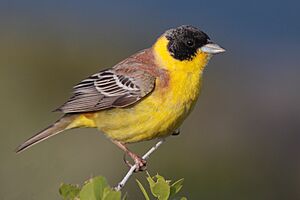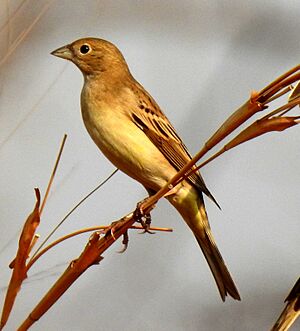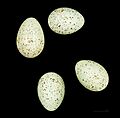Black-headed bunting facts for kids
Quick facts for kids Black-headed bunting |
|
|---|---|
 |
|
| Adult male (Lesbos, Greece) | |
 |
|
| Female (Maharashtra, India) | |
| Conservation status | |
| Scientific classification | |
 |
|
| Breeding and winter distribution ranges of Black-headed and Red-headed Bunting | |
| Synonyms | |
|
The black-headed bunting (Emberiza melanocephala) is a small passerine bird. This means it's a type of perching bird, like many songbirds. It belongs to the bunting family.
These birds live in south-east Europe and as far east as Iran. When winter comes, they fly long distances. Most travel to India, but some go even further into south-east Asia. Black-headed buntings prefer open areas like grasslands. They often fly in groups, looking for seeds and grains to eat.
Adult male black-headed buntings are easy to spot. They have bright yellow bellies, a chestnut-colored back, and a black head. Females look a bit like the males but are duller. It can be tricky to tell young birds apart from the similar red-headed bunting. Sometimes, these two species even have babies together where their homes overlap.
Contents
Meet the Black-Headed Bunting
The black-headed bunting was first officially described in 1769. This was done by a scientist named Giovanni Antonio Scopoli. He gave it the scientific name Emberiza melanocephala. The name Emberiza comes from an old German word for a bunting. Melanocephala is from ancient Greek words meaning "black" and "head." This perfectly describes the male bird!
What Does It Look Like?
This bird is about 15 centimeters (about 6 inches) long. It's a bit bigger than a reed bunting and has a long tail.
Male and Female Differences
- Breeding Male: Has bright yellow underparts. Its back is a rich chestnut color. The head is a striking black.
- Female: Looks like a faded version of the male. Her underparts are paler yellow. Her back is grey-brown, and her head is greyish.
Young Birds
Young black-headed buntings are similar to females. Their belly area (vent) is yellow. It can be hard to tell them apart from young red-headed buntings. However, black-headed buntings usually have darker cheeks than their throats. First-year males have a grey crown. Their back has patches of chestnut and grey. First-year females can be very hard to tell from female red-headed buntings. But they tend to have more streaks on their crown than on their lower back. Their vent is also yellow.
Where Do They Live and Travel?
Black-headed buntings like to breed in open areas. This includes scrubby land and even farms. When winter arrives, they fly to Asia. You can find huge groups of them in farm fields and grasslands.
Amazing Migrations
These birds are incredible travelers! One bird that was tagged flew about 7,000 kilometers (over 4,300 miles). Another tagged bird flew 1,000 kilometers (about 620 miles) in just seven days!
Males often travel in groups by themselves. They arrive at their winter homes before the females do. In India, their main wintering area is in the western and northern parts. It stretches south to northern Karnataka. In winter, they gather in large groups to sleep. They often roost in thorny acacia trees. Sometimes, they even join other birds like the yellow-throated sparrow.
Their main breeding areas are from south-eastern Europe to central Asia. While most spend winter in India, some have been seen far east. This includes places like Japan, China, and Thailand. Sometimes, they even visit northern Europe, like Norway, during the summer.
How Do They Behave?
Black-headed buntings often feed in flocks. They search for seeds in grasslands.
Nesting and Babies
They build their nests in the summer. Nests are usually in a low bush or on the ground. The nest is shaped like a cup. It's made of dry grass and lined with soft hair. Females usually lay four to six eggs. The eggs hatch after about 13 days. The baby birds leave the nest after about 10 days.
What Do They Eat?
When feeding their young, black-headed buntings eat insects. At other times, their main food is seeds.
Calls and Songs
In winter, their call is a simple "tweet" or a soft zrit. Their song is loud and clear. It's a series of high, harsh notes that get faster. It sounds like a jangling mix with some clear, slurred notes. Then it stops suddenly.
Images for kids





